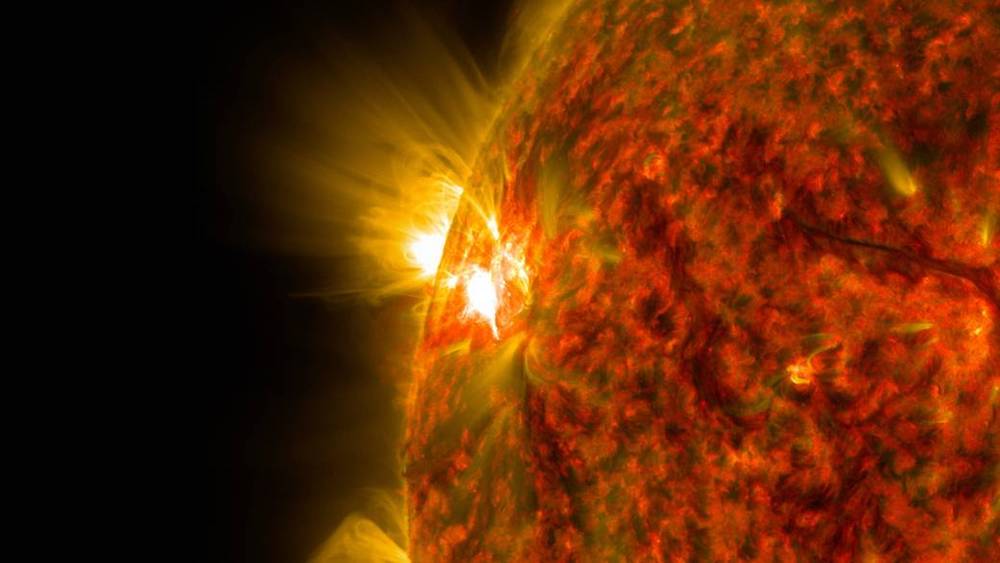Create a free profile to get unlimited access to exclusive videos, sweepstakes, and more!
Could a bizarre star explain why our Sun's birthmarks suddenly vanished back in the 17th century?
It wasn't wearing concealer.

Human eyes weren’t made to stare at the Sun, but telescope images like the one above expose dark spots on the otherwise blazing surface. They do look kind of like birthmarks.
For seemingly no reason at all, those “birthmarks” vanished hundreds of years ago only to reappear some decades later. What caused this remains unknown. From the mid 1600s through the early 1700s, the Sun’s 11-year sunspot cycle suddenly shut down in a phenomenon now known as the Maunder Minimum. Now a nearby star much like the Sun could explain why this occurred, because this star has not had a starspot since 2003.
HD 166620 is only about 36 light-years away from the Sun and 0.79 times as massive. It was one of 59 stars whose starspot data over the last 50 to 60 years was studied by a team of astronomers, including Jason Wright and Howard Isaacson, who coauthored a study recently published in The Astronomical Journal. Observations over half a century show that this star was cycling like any other before something got switched off. Thought to have had a cycle of 17 years, it isn’t that active these days, though space weather can be unpredictable.
“Potentially being in a Maunder Minimum state means that this star has exceptionally low stellar activity,” Isaacson told SYFY WIRE. “As our instruments to collect Doppler measurements improve, we become limited only by the stellar activity of the star.”
Starspots appear dark because they are cooler (still scorching, but less scorching) than the fires around them. When you compare 6,700° F with 10,000° F, the starspot is going to sound like hell with air conditioning. Any starspot would appear at least as bright as a full moon if it wasn’t surrounded by even brighter plasma. They show up when there is a disturbance in a star’s magnetic field that makes its way to what we see on Earth as the visible surface of a star, or its photosphere. They take anywhere from days to weeks to form and can hold up for months.
Because starspots emerge from disturbed magnetic fields, they are also associated with coronal mass ejections, and sunspots can mean a geomagnetic storm. Charged particles in the solar wind can mess with satellites and our electronic infrastructure, not to mention pose a radiation hazard to astronauts on the ISS. Understanding more about sunspots could help us predict volatile space weather before solar plasma hits Earth.
“We are more likely to suffer geomagnetic storms during periods of high sunspot activity, which corresponds to times when the sun releases more coronal mass ejections,” Wright also told SYFY WIRE. “For closer planets, stellar magnetic activity can affect planetary habitability.”
By going through observations from the Mount Wilson Observatory HK project, which was sungazing from 1966 to 1996, and Keck Observatory (which was technically searching for planets but picked up on star activity anyway), the astronomers found that 29 of the stars they had their eye on showed evidence of starspot cycles. Each went through at least two cycles, with a cycle typically lasting over a decade. Why some stars did not have cycles is a mystery. It is possible they were either dying or rotating too slowly for their magnetic fields to act up.
When the data revealing HD 166620’s strange lack of starspots first came to light, the team thought there might have been an error. Every possibility was explored, and every piece of information was back checked again and again, from observation times to where the star was in the sky at any given moment. It turned out that this was no glitch, unless you counted the star itself glitching. It was a stellar aberration. Seeing a starspot cycle just go dead out of nowhere brought them back to wondering what could have caused the Mauder Minimum.
Something about the strength of the magnetic field and magnetic structure of HD 166620 might eventually provide some insight about what happened to the Sun before there were powerful telescopes to see the phenomenon in action.
“Stars like this offer an opportunity to push the detection limits lower,” said Isaacson. “This is how we could identify even lower mass planets that may otherwise be buried in the stellar noise of the star.”


























